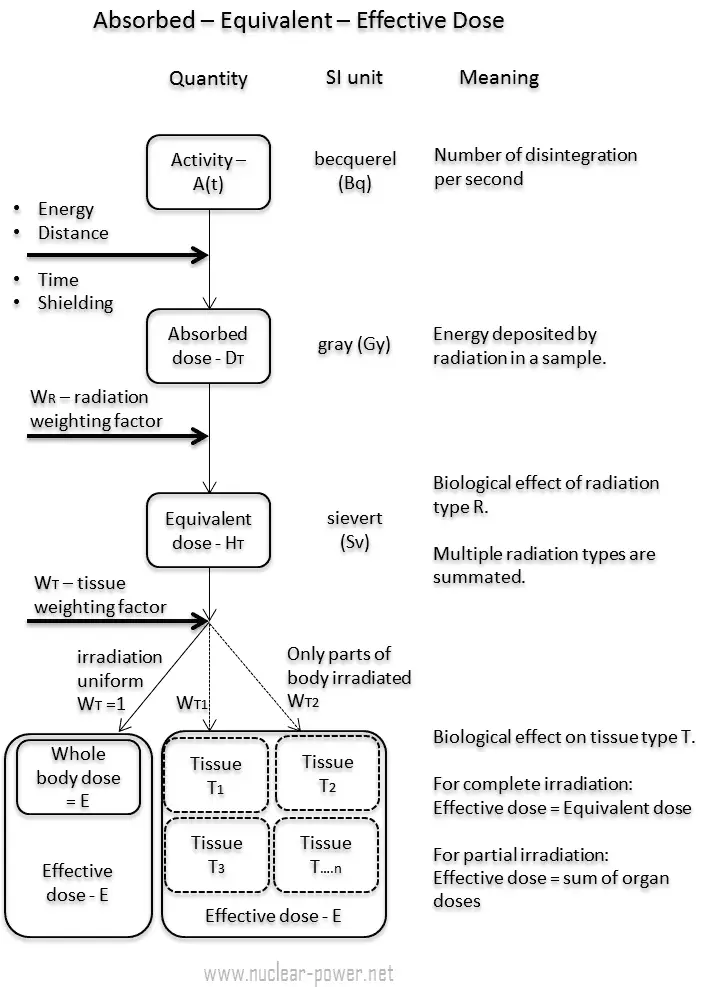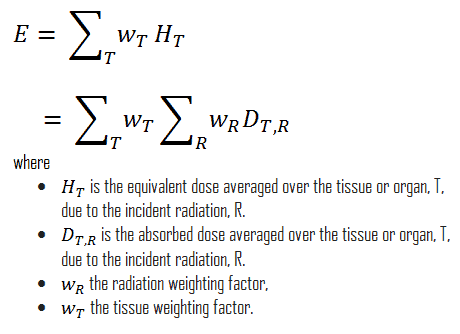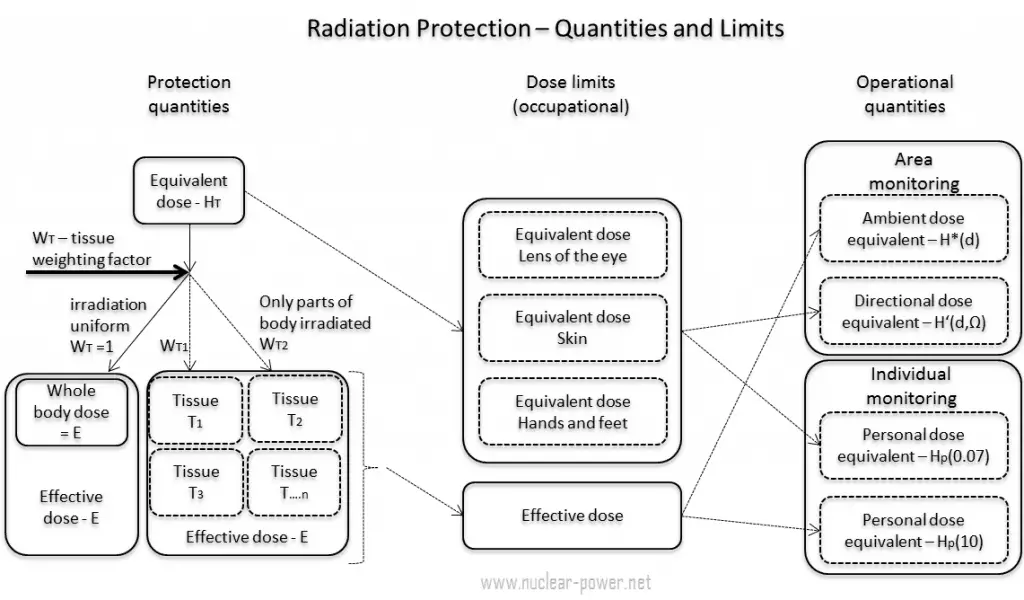This chapter briefly summarizes key differences between quantities and units of radiation.
Activity – Specific Activity
A measure of radioactivity (activity) is based on counting disintegrations per second. The SI unit of activity is the becquerel (Bq), equal to one reciprocal second. The activity depends only on the number of decays per second, not on the type of decay, the energy of the decay products, or the biological effects of the radiation. It can be used to characterize the rate of emission of ionizing radiation. Specific activity is the activity per quantity of a radionuclide. Thus specific activity is defined as the activity per quantity of atoms of a particular radionuclide. It is usually given in units of Bq/g, but another commonly used unit of activity is the curie (Ci), allowing the definition of specific activity in Ci/g.
Units of radioactivity (the curie and the becquerel) can also be used to characterize an overall quantity of controlled or accidental releases of radioactive atoms.
Units of Radioactivity
- Becquerel. The becquerel is the SI unit of radioactivity defined in 1974, and it is named in honor of Henri Becquerel, a French physicist who discovered radioactivity in 1896. One becquerel (1Bq) is equal to 1 disintegration per second.
- Curie. A curie is a non-SI unit of radioactivity defined in 1910. It was originally defined as equivalent to the number of disintegrations one gram of radium-226 will undergo in one second. Currently, a curie is defined as 1Ci = 3.7 x 1010 disintegrations per second.
- Rutherford. Rutherford (symbol Rd) is also a non-SI unit defined as the activity of a quantity of radioactive material in which one million nuclei decay per second.
Exposure
Radiation exposure is defined as the sum of electrical charges (∆q) on all the ions of one sign produced in the air when all the electrons, liberated by photons in a volume of air whose mass is ∆m, are completely stopped in the air. Radiation exposure is given the symbol X. The SI unit of radiation exposure is the coulomb per kilogram (C/kg), but in practice, the roentgen is used.
Unit of Exposure
- Roentgen. The roentgen, abbreviated R, is the unit of radiation exposure. In the original definition, 1 R means the amount of X-rays or γ-radiation required to liberate positive and negative charges of one electrostatic unit of charge (esu) in 1 cm³ of dry air at standard temperature and pressure (STP).
Kerma
Kerma is a measure of kinetic energy transferred from radiation to matter, and it is an acronym for “kinetic energy released per unit mass.” Kerma is given the symbol K, measured by the SI unit, the gray.
Absorbed Dose
The absorbed dose is defined as the amount of energy deposited by ionizing radiation in a substance, and the absorbed dose is given the symbol D.
Units of Absorbed Dose
- Gray. A dose of one gray is equivalent to a unit of energy (joule) deposited in a kilogram of a substance.
- RAD. A dose of one rad is equivalent to depositing one hundred ergs of energy in one gram of any material.
Equivalent Dose
Equivalent dose (symbol HT) is a dose quantity calculated for individual organs (index T – tissue). The equivalent dose is based on the absorbed dose to an organ, adjusted to account for the effectiveness of the type of radiation. An equivalent dose is given the symbol HT.
Units of Equivalent Dose:
- Sievert. A sievert is a derived unit of equivalent dose and effective dose. It represents the equivalent biological effect of depositing a joule of gamma rays energy in a kilogram of human tissue.
- REM. The rem (an abbreviation for Roentgen Equivalent Man) is the non-SI unit of the equivalent dose used predominantly in the USA. It is a term for dose equivalence and equals the biological damage that would be caused by one rad of dose.
Effective Dose
The effective dose is a dose quantity defined as the sum of the tissue-equivalent doses weighted by the ICRP organ (tissue) weighting factors, wT, which considers the varying sensitivity of different organs and tissues to radiation.
Units of Effective Dose
- Sievert. A sievert is a derived unit of equivalent dose and effective dose. It represents the equivalent biological effect of depositing a joule of gamma rays energy in a kilogram of human tissue.
- REM. The rem (an abbreviation for Roentgen Equivalent Man) is the non-SI unit of equivalent dose and effective dose used predominantly in the USA. It is a term for dose equivalence and equals the biological damage that would be caused by one rad of dose.
Operational Quantities
In general, the ICRP defines operational quantities for the area and individual monitoring of external exposures.
Area Monitoring
- Ambient dose equivalent, H*(10). The ambient dose equivalent is an operational quantity for area monitoring of strongly penetrating radiation.
- Directional dose equivalent, H’ (d, Ω). The directional dose equivalent is an operational quantity for area monitoring weakly penetrating radiation.
Individual Monitoring
- Personal dose equivalent, Hp(0.07). The Hp(0.07) dose equivalent is an operational quantity for individual monitoring to assess the dose to the skin, hands, and feet.
- Personal dose equivalent, Hp(10). The Hp(10) dose equivalent is an operational quantity for individual monitoring to assess the effective dose.


